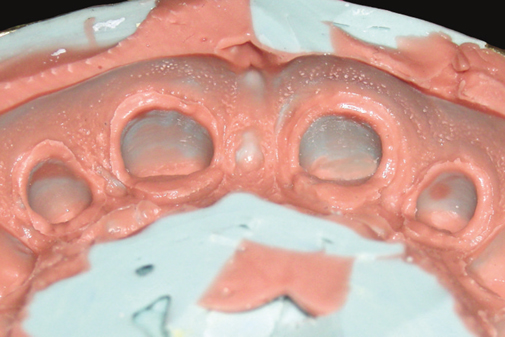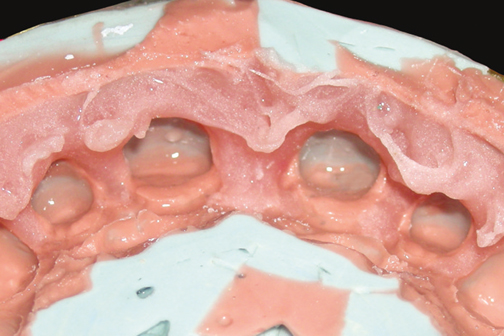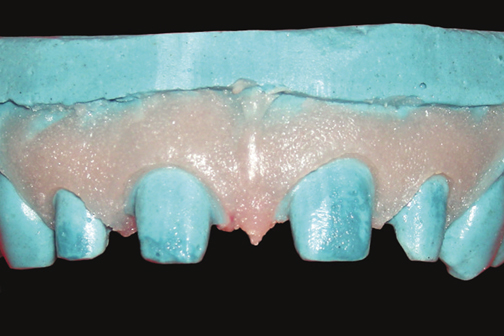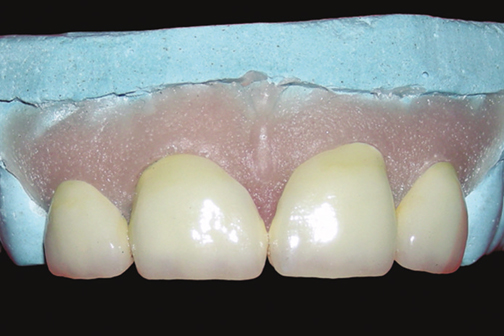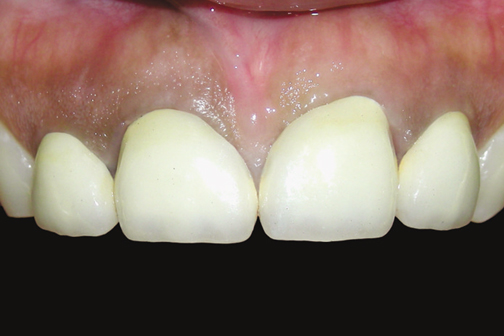J Adv Prosthodont.
2011 Mar;3(1):33-36. 10.4047/jap.2011.3.1.33.
Modified soft tissue cast for fixed partial denture: a technique
- Affiliations
-
- 1Department of Prosthodontics, Government Dental College & Hospital, Nagpur, Maharashtra, India. pravinandsmita@yahoo.co.in
- KMID: 1975112
- DOI: http://doi.org/10.4047/jap.2011.3.1.33
Abstract
- In process of fabrication of a fixed partial denture, dies are trimmed to expose margins of the preparations. The need for the soft tissue cast is quite evident as the soft tissue emergence profile that surrounds the prepared tooth is destroyed in the process of fabrication. This article describes a modified technique to fabricate the soft tissue cast for the conventional fixed partial denture. The impression made with the polyvinylsiloxane was first poured to prepare the die cast. After retrieval of the cast, the same impression was poured second time with the resin based resilient material to cover the facial and proximal gingival areas. The remaining portion of the impression was poured with the gypsum material. This technique does not require additional clinical appointment, second impression procedure, technique sensitive manipulations with impression, or cumbersome laboratory procedures. The simplicity of this technique facilitates and justifies its routine use in fabrication of the fixed partial denture.
Figure
Reference
-
1. Tung FF, Nourbakhsh N, Bahn C. Accurate procedure for simultaneous registration of gingival emergence profile and maximal intercuspal position for metal ceramic restorations. J Prosthet Dent. 2000. 83:681–685.2. Perel ML. Periodontal considerations of crown contours. J Prosthet Dent. 1971. 26:627–630.3. Yuodelis RA, Weaver JD, Sapkos S. Facial and lingual contours of artificial complete crown restorations and their effects on the periodontium. J Prosthet Dent. 1973. 29:61–66.4. Jameson LM, Malone WF. Crown contours and gingival response. J Prosthet Dent. 1982. 47:620–624.5. Williamson RT, Breeding LC, Kinderknecht KE. Soft tissue cast aids in establishing interproximal contours for restorations. J Prosthet Dent. 1993. 69:630–631.6. Bassiouny MA, Yearwood LL. Establishing the gingival emergence profile of restorations by using a resilient gingival replica. J Prosthet Dent. 1996. 76:386–389.7. Nayyar A, Moskowitz M, Pollard BL. Improving the emergence profile of dental restorations with accurate reproduction of soft tissue topography. J Esthet Dent. 1995. 7:26–31.8. Tan PL, Ruder GA. Simple(r) soft tissue masque for individual fixed restorations. J Prosthodont. 2004. 13:192–194.9. Holtan JR, Olin PS, Rudney JD. Dimensional stability of a polyvinylsiloxane impression material following ethylene oxide and steam autoclave sterilization. J Prosthet Dent. 1991. 65:519–525.10. Beyak BL, Chee WW. Compatibility of elastomeric impression materials for use as soft tissue casts. J Prosthet Dent. 1996. 76:510–514.11. Gerrow JD, Price RB. Comparison of the surface detail reproduction of flexible die material systems. J Prosthet Dent. 1998. 80:485–489.
- Full Text Links
- Actions
-
Cited
- CITED
-
- Close
- Share
- Similar articles
-
- Pontic site development and soft tissue transfer of the esthetic area: a case report
- An implant-supported removable partial denture for a patient with post-inflammatory scar contracture caused by burn complications: a clinical report
- Immediate fixed partial denture after tooth extraction in patients with systemic diseases: A clinical report
- Rehabilitation of maxillary partial edentulous patients using implant assisted removable partial denture
- Combined application of roll flap and combination onlay-interpositional graft to enhance esthetics of maxillary anterior fixed partial denture: A case report

